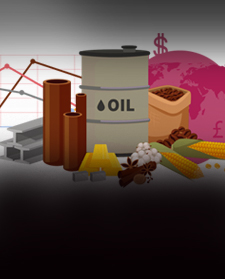
Advantage AxisDirect
- 20 investment products
- 3 great platforms to invest
- 5 fun-tastic learn courses
- 5 powerful research segments
- 4 prestigious awards
- 9 lakh+ happy investors
Quotes
Back To Menu
-
Offerings
- Overview
- Products
- Platforms - RING
- DIGITAX
- Managed Accounts
- Private Client Group
- Business Associates
- NRI
- REFER & EARN
- Insurance
- SGB
- Markets
- Research
- Learn
- PORTFOLIO
- PROFILE
5 Things you must know before trading in commodities
Sep 22, 2022

The commodities market is the place for trading cereals, oil, metals, spices, natural gas, livestock, and crude oil, etc. Investors purchase commodities for portfolio diversification and generating better returns. Most of the trading happens through a futures contract that determines the purchase and sale price of the commodities. However, direct investing in commodities can be pretty challenging, due to the additional costs and risks that are unique to commodity trading.
Hence, it’s best to do your homework before you start trading in commodities. Here are the 5 factors that you need to know about before trading in commodities:
(1) Squaring Positions Before Expiry
A trader can hold two types of positions in the market—open or closed. If a trade has an open position, it means the trader still has an option to incur a profit/loss on it. On the other hand, if a trade has been canceled, it is a closed position. In commodity trading, investors do not intend to take physical delivery of the commodity they have invested into most of the time. Hence, you need to be mindful about squaring off your positions before the expiry of the term. Squaring off refers to earning profits by selling assets purchased on the same day for a higher price than the buying price.
(2) Volatility of the Commodities Market
The prices of commodities are extremely volatile. They are subject to wide swings and can trend lower for longer periods. Even for individual commodity investors, it is critical to time these markets. Whether the investment is short term or long term, investors must aim to buy and sell at the correct time. It could be a shocker and an emotional roller coaster ride for any investor who is not prepared for such swings in advance.
(3) Optimal Portfolio Diversification
The commodities market has an inverse relationship with the stock market, which implies that you can achieve optimal portfolio diversification by allocating your investments between the two markets. However, you need to consider various aspects before choosing commodity futures as a diversification tool such as the cost of holding the particular commodity, its riskiness, its liquidity, and past performance.
(4) Monitor Margin Requirements
The margin money for commodities trading is based on the commodity contract value, and this margin amount must be deposited before buying/selling positions in commodities. Often, exchanges impose additional margins on the investors; hence, it is important to track margins and keep an account of the additional costs associated with commodity trading.
(5) Extended Trading Hours
Commodity traders are aware that the sale and purchase of commodities take place beyond the usual trading hours. This is also known as extended trading hours and primary reasons for introducing extended trading hours are to be at par with global standards, offer convenience to part-time traders and enable quicker response to critical news that could impact commodity prices.
Being the trader is mindful of extended trading hours, it might help him to skip losses, or earn huge profits due to favorable situations during those hours. However, you must also know that extended trading hours have several disadvantages as well.
During pre and post hours, liquidity is at its lowest. Buyers and sellers might not be easily available and lower trading volume could make it difficult for traders to execute trade. It’s common for investors to witness partial or no fills for their orders, in the extended trading hours.
Another problem during the extended trading hours is that investors might not get the best prices for their stocks. This is because in the after-hours, stock prices aren't regularly updated.
(6) Maintain a good mix of commodities
Before you start investing in commodities, it is essential that you understand the various asset classes. The five major types of commodity classes are:
- Energy: Crude oil, natural gas, coal or green energy
- Precious Metals: Gold, Silver, Platinum, Copper, Iron Ore
- Livestock: Pork, Beef, Feeder Cattle, Live Cattle
- Grains: Rice, Wheat, Corn, Soy, Oats, Barley
- Softs: coffee, cocoa, sugar. Softs are the futures contracts on underlying agricultural commodities that are grown, not extracted or mined
For a balanced portfolio, a trader must know the performance of all the types of commodities and choose wisely to include in his portfolio.
Conclusion
As commodity trading has gained a lot of momentum in the recent past, several investors and traders are getting attracted to it. The pointers that we have mentioned above will serve as a guideline for such investors so that they incur minimal losses and maximize their losses.
To know more how to start with commodity trading on Axis Direct, watch this video.
Related Keyword
MCX
NCDEX
commodities
Similar Articles

Inflexion Point: Concept In Commodities Market | Commodity Derivatives – Axis Direct
Dec 05, 2018 | Source: www.thehindubusinessline.com

A Millennial’s Guide To Commodity Derivatives – Axis Direct
May 10, 2019 | Source: www.moneycontrol.com
Show more...




 India
India NRI
NRI

